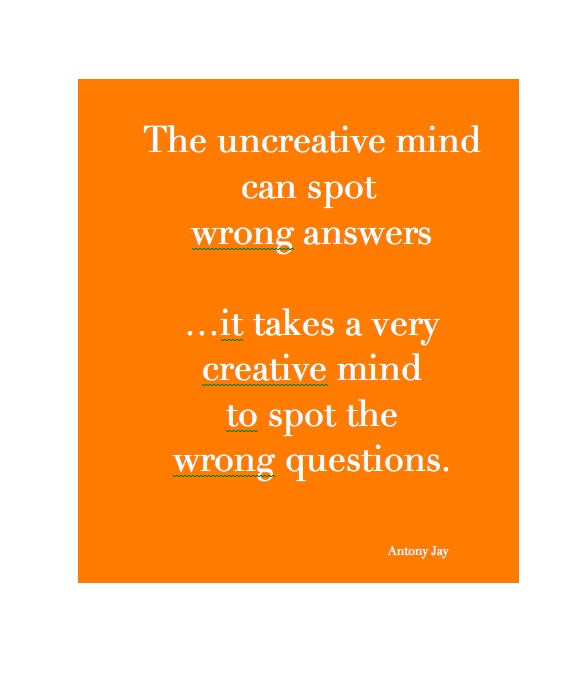What is the difference between creativity and innovation - and does it matter?
Knowing the difference between the two is important in terms of appreciating where and how creative innovation best happens. It is also useful to dispel some myths about those best qualified to be invited to be part of the process in the first place.
There are notions that creative behaviour is the exclusive domain of Creatives. Not great news for lesser mortals - and definitely a reductive definition of what it means to be creative.
In other articles we have shared our thoughts on the variety of ways that people may be creative in their work, whatever their role. Suffice to say that however new ideas are uncovered, whether via forensic fact-finding, through anarchic improvisation or rule breaking, by reframing challenges to find new meanings or solutions - we hold that creativity has many incarnations.
In whatever form creativity occurs, it still may not ultimately result in innovation - or doing things differently in a real and practical sense. What does seem clear though is that neither creativity nor innovation are likely to flourish in an atmosphere where results-driven activity is the norm.
Deadlines may work for some, but for others being faced with a blank page feels too much. Aside from a stupefying lack of surging inspiration, the pressure to deliver something, anything, may mean that they will share their first thoughts or safer bet suggestions. Potentially they could be offering less valuable ideas just to stay within schedule and keep people happy.
Professor Guy Claxton nails the dilemna when he talks about how we are constantly wired to jump through the productivity hoop.
He argues that exploring unchartered possibilities requires different conditions, those where our slower unconscious processes, or what he terms our tortoise minds, have time to mull over ideas to find more innovative solutions. This means giving our hare brains, our relentless target reaching selves, permission to take a sabbatical.
This idea of slapping a banning order on our more businesslike or rational selves for periods of time is apparently key to unlocking the potential for creative innovation.
Yet, clearly, outside of those industries where creativity for its own sake is the norm, there may be fear or cynicism of breaking patterns or wasting time - so deviating from the status quo has to be managed carefully.
Why would those under huge pressure to deliver against specific targets, against tight budgets or tighter time schedules welcome frivolity into their boardrooms?
John Cleese, a great advocate of creativity, argues that those with important responsibilities need to be reminded that while they keep busy, doing what feels rational and comfortable, they are missing the point.
There is a real danger that by the time they come up for air to discover their annual profits have fallen because their systems, products or services have become obsolete, its too late. Not a great survival strategy in our rapidly changing markets. He offers the ideal recipe for ideation and suggests five necessary ingredients...
According to Cleese, bursts of creative play need to start and then end so that the best ideas can be probed for their feasibility - and fun brainstorming sessions, for example, can generate far more than colourful spider charts.
While there's busy and there's productive, there is also time for practicalities and time for imagining. The former is vital when it comes to questioning the feasibility and logic of new proposals at the implementation phase of the invocation process. On the other hand, devil's advocate-type interventions during other parts of the process can be downright destructive.
The less helpful aspect of logical reasoning is how swiftly it may seek only the flaws in embryonic or seemingly ill conceived ideas - and nay sayers can strangle creativity at birth. Focusing upon the practicalities of how something might happen at the ideation stage is also not especially helpful.
So, to avoid bludgeoning seemingly daft ideas before they have the chance to bear potential fruit, reason needs to be bound and gagged at certain points - then to be untied later to oxygenate the way forward.
For simplicity’s sake, consider how we work with our clients through this process and where and how open or closed modes of thinking can be most helpful...
three stages of creative innovation
stage one - envisions the ideal future, then focuses upon building the business case for change by
identifying the pivotal question to be answered
illustrating, in the face of current reality, why it needs to be answered
inspiring others with the future vision
stage two - encourages
ideation
imaginations to run riot to invent
incubation of potential ways forward
stage three - explores ways to
influence
implement
and insure
Aside from lots of words beginning with the letter i, you'll note how both open and closed modes of creative thinking are important throughout the process of innovation - even at the very start in identifying the right questions to ask...
If you want to know more about how we can help you to find the right questions, we would love to hear from you...





